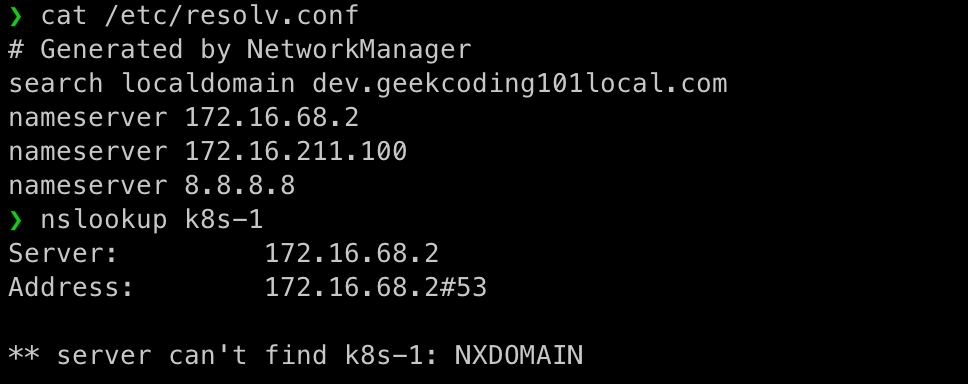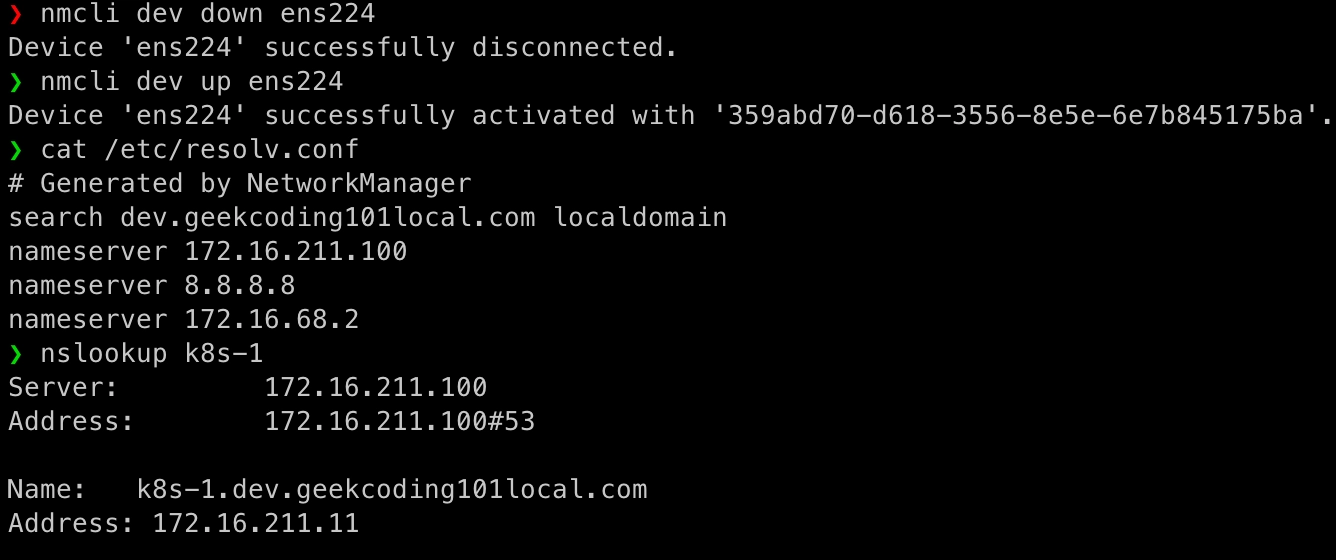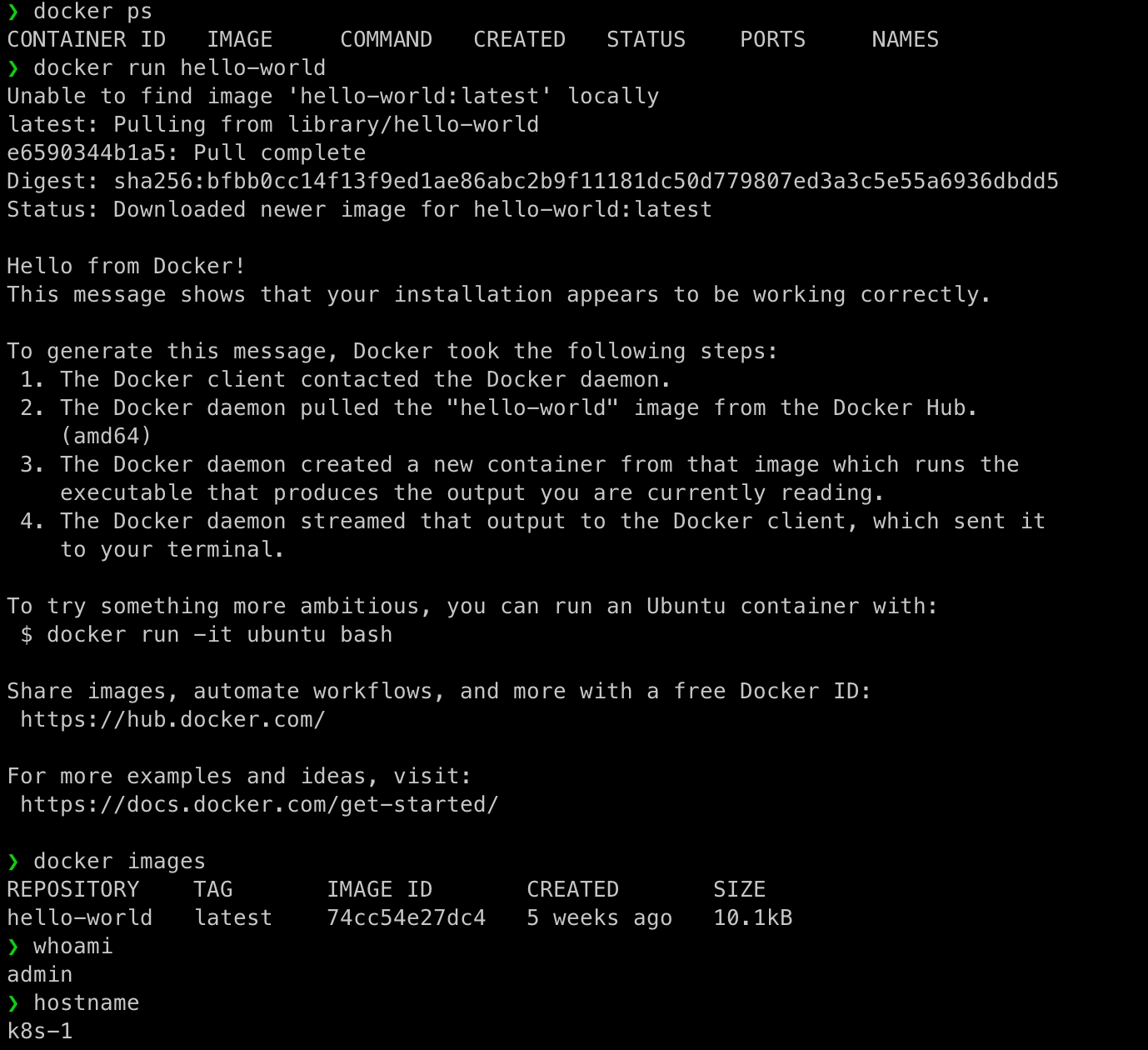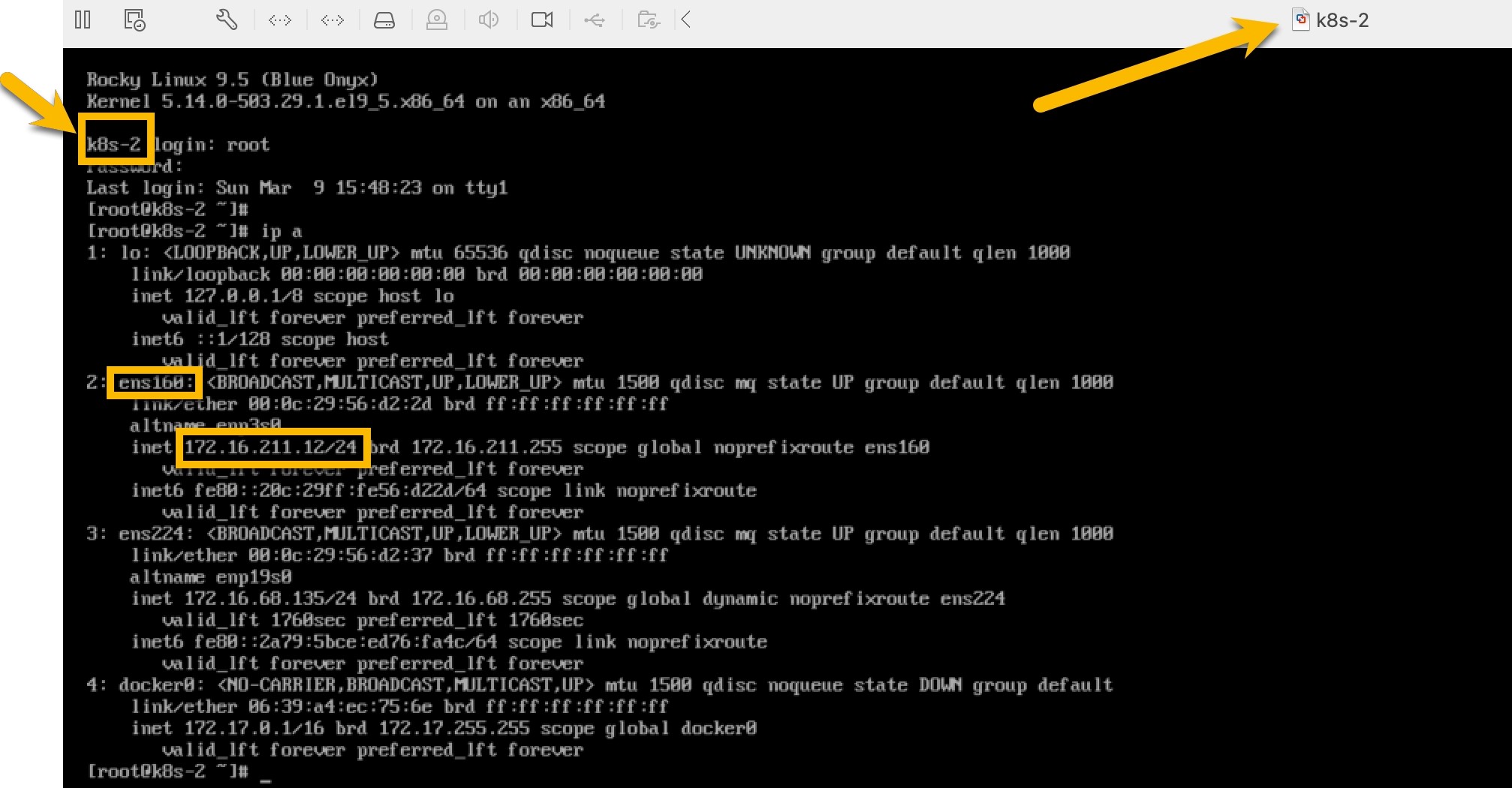Introduction
Welcome back to the Kubernetes tutorial series! Now that our base image and local server are ready, it’s time for the real action—Kubernetes cluster setup with Flannel. I'll spin up one Kubernetes master and 4 worker nodes, forming a local Kubernetes cluster that’s ready for real workloads. No more theory—let’s build something real! 🚀
Clone baseimage to k8s-1 as The Kubernetes VM Base Image
Before jump on our Kubernetes cluster setup, let's start from my Mac's terminal, clone from Base Image - Rocky 9 as k8s-base:
❯ vmrun clone /Users/geekcoding101.com/Virtual\ Machines.localized/baseimage-rocky9.vmwarevm/baseimage-rocky9.vmx /Users/geekcoding101.com/Virtual\ Machines.localized/k8s-1.vmwarevm/k8s-1.vmx full ❯ sed -i '' 's/displayName = "Clone of baseimage-rocky9"/displayName = "k8s-1"/' "/Users/geekcoding101.com/Virtual Machines.localized/k8s-1.vmwarevm/k8s-1.vmx"
Make sure you've stopped the baseimage VM, start the k8s-base VM.
The steps here I've mentioned details in Part 2, in short, after above command, we need to rescan in VMFusion and SSH as root into the k8s-base using the IP172.16.211.3 of the base VM, preapre the input file /opt/share_tools/init_data/k8s-1_vm_input.json:
{
"hostname": "k8s-1",
"ip": "172.16.8.11",
"subnet": "24",
"gateway": "172.16.211.2",
"dns1": "172.16.211.100",
"dns2": "8.8.8.8",
"domain": "dev.geekcoding101local.com",
"ansible_key_path": "~/.ssh/ansible_ed25519",
"ssh_key_path": "~/.ssh/ssh_ed25519"
}
Then using VMFusion console to login into the VM, perform below command to generate SSH keys and setup networking:
ansible-playbook /opt/share_tools/bin/configure_vm.yml -e "input_file_path=/opt/share_tools/init_data/k8s-1_vm_input.json"
Now I can connect from SSH passwordlessly via the new IP 172.16.8.11.
Test DNS
Please note here is testing our local DNS server to ensure it's working in our Kubernetes cluster setup. But it's not going to replace CoreDNS...
Anyway, ensure the DNS server localserver(172.16.211.100) we setup in Part 2 is running.
Ensure the 172.16.211.100 is on top of /etc/resolv.conf , should be same as below:
❯ cat /etc/resolv.conf # Generated by NetworkManager search localdomain dev.geekcoding101local.com nameserver 172.16.211.100 nameserver 8.8.8.8 nameserver 172.16.68.2
The 172.16.68.2 is assigned by ens224, the network adapter we added into VM for internet access. BecauseVMware Fusion typically assigns 172.16.68.1 and 172.16.68.2 as DNS servers for virtual machines when using NAT (Network Address Translation) networking.
Test DNS and hostname as below as root:
nslookup k8s-1 nslookup k8s-1.dev.geekcoding101local.com hostname -f hostname -s

172.16.68.2 on top of /etc/resolv.conf, you would hit:
I don't recommend to manually update /etc/resolv.conf to fix it as you've seen "Generated by NetworkManager".
The reason why 172.16.68.2 is ahead of 172.16.211.100 is the order of nmcli command on the network adatper ens160 and ens224.
Now if we shut down ens224 and bring up it again,172.16.68.2 will be shown at the bottom of /etc/resolv.conf:
nmcli dev down ens224 nmcli dev up ens224
Setup Docker
In k8s-1 SSH session, now we can install common packages required by Kubernetes cluster setup.
In this Kubernetes cluster setup, we will use k8s-1 as a base image, so we can easily clone it as k8s-2, k8s-3, k8s-4 and k8s-5 without repeat the common packages installation!
dnf update -y dnf config-manager --add-repo=https://download.docker.com/linux/centos/docker-ce.repo dnf install docker-ce docker-ce-cli containerd.io socat -y systemctl enable --now docker systemctl start docker systemctl status docker
socat is required by kubeadmin init which we will run later, without it, you will hit a warning as below:
Docker-ce and docker-ce-cli are not necessary and deprecated since Kubernetes 1.20+, as Kubernetes no longer relies on Docker as its container runtime.However,
Docker can still be useful in a development environment, offering a full containerization platform that includes tools for building images, managing networks, volumes, and simple orchestration.
But it will introduce a problem in /etc/containerd/config.toml that it will disable cri like this:
disabled_plugins = ["cri"]
This has an important impact on how containerd integrates with Kubernetes.
The CRI plugin is specifically needed when we're using containerd as our container runtime for Kubernetes. The CRI plugin enables containerd to communicate with Kubernetes by implementing the Container Runtime Interface (CRI), which Kubernetes uses to manage containers. When using Docker, it will not need cri, that's why above docker installation disabled it. But I've mentioned previously why I want to have docker and I want to usecontainerd as our container runtime, so let's just fix the configuration issue.
Just regenerate the config.toml which will enable cri plugin by default, but needs to manually update SystemdCgroup to true via below commands:
containerd config default | sudo tee /etc/containerd/config.toml sed -i 's/SystemdCgroup = false/SystemdCgroup = true/' /etc/containerd/config.toml
Kubernetes uses cgroups for managing resources like CPU, memory, and I/O for containers. If SystemdCgroup = true, containerd integrates with systemd to manage cgroups, which is the preferred method on most modern Linux distributions using systemd as their init system (e.g., Rocky Linux, etc.).
Execute Docker Command Without sudo As Non-root Accounts
If running as a non-root account, you will encounter this permission error:
[admin@k8s-01 ~]$ docker ps permission denied while trying to connect to the Docker daemon socket at unix:///var/run/docker.sock: Get "http://%2Fvar%2Frun%2Fdocker.sock/v1.47/containers/json": dial unix /var/run/docker.sock: connect: permission denied [admin@k8s-01 ~]$
So let's add the use into docker group:
[admin@k8s-1 ~]$ sudo usermod -aG docker $(whoami)
Log out of the current session and log in again as admin and you should see docker ps started working now.
Let's test docker (how about switch back to root account to perform the testing...):
docker run hello-world
Configure OS To Support Kubernetes
Disable swap for Kubernetes
swapoff -a sed -i '/swap/d' /etc/fstab
Configure Linux kernel’s networking parameters
br_netfilter: Kubernetes uses network bridges to connect Pods, and the br_netfilter module ensures that iptables can see and manipulate bridged traffic. This is essential for Kubernetes' internal networking (such as inter-Pod communication and service routing).
Overlay in /etc/modules-load.d/k8s.conf: is not needed on rocky 9. Because I found it's already loaded:
❯ modinfo overlay
filename: /lib/modules/5.14.0-427.37.1.el9_4.x86_64/kernel/fs/overlayfs/overlay.ko.xz
alias: fs-overlay
license: GPL
description: Overlay filesystem
author: Miklos Szeredi <miklos@szeredi.hu>
rhelversion: 9.4
srcversion: 6DB4565DD58AB453DBFAD2A
depends:
retpoline: Y
intree: Y
name: overlay
vermagic: 5.14.0-427.37.1.el9_4.x86_64 SMP preempt mod_unload modversions
sig_id: PKCS#7
signer: Rocky kernel signing key
sig_key: 52:A7:4C:F4:7A:B4:B1:12:D3:1E:72:33:0A:0D:49:8B:C3:34:88:DC
sig_hashalgo: sha256
signature: 18:AF:F5:F2:12:80:5A:92:B3:5E:29:B2:A5:10:E8:27:90:73:B4:B2:
25:B0:04:42:2B:28:FF:86:50:0D:82:CA:12:68:93:70:9F:04:C5:3C:
19:B2:29:47:41:DD:7F:1D:33:18:33:B7:50:2C:30:A4:0D:CB:1E:53:
4A:66:B8:BF:CB:41:F8:89:3E:5E:CA:63:8B:0C:2F:CD:42:AD:63:9D:
C4:6A:31:FD:4B:46:0C:33:38:5A:BA:11:B0:66:76:BF:54:7B:B7:63:
35:1B:76:52:D2:04:BF:83:65:A7:C6:0D:D1:CB:96:BF:60:37:54:37:
3E:1B:76:69:9C:2F:8F:8D:81:21:88:33:96:EA:E6:C3:97:D1:1E:8F:
BC:BD:70:82:27:2A:F3:8C:11:1D:AC:AC:13:00:F6:CD:00:BD:6C:3E:
40:6F:F2:54:9C:E3:62:A7:17:78:4C:3C:43:A0:49:4D:61:FE:FD:A6:
CD:51:5F:E6:F3:47:B7:70:D4:5E:55:3C:B8:8C:D5:45:81:6F:47:E4:
80:39:E1:BA:0D:79:21:64:A6:7E:4D:ED:59:09:F1:26:D2:06:98:E5:
EB:E5:B1:58:F5:AF:89:0B:0E:8B:65:EB:2A:83:30:48:FD:AC:48:AB:
12:39:EF:3C:BB:DA:CC:26:F8:38:7F:C8:2D:15:7D:4D:3A:E6:8F:AA:
AB:16:79:39:2D:2E:9D:5B:76:29:6F:BE:74:4E:65:F5:1F:01:43:58:
DE:12:54:B5:C7:9E:A5:4C:B0:1D:5E:9B:05:AF:CF:B8:33:28:B4:8E:
6E:A1:E1:58:7D:CC:F2:61:51:EA:B1:C0:BD:BE:02:56:43:6D:5A:67:
D7:F0:25:02:91:70:74:AE:F4:6F:D3:E9:9A:1E:D0:DD:BA:C2:3C:B3:
07:C4:F3:AD:37:63:6B:2B:B9:1D:FB:0B:CC:0B:B7:E3:14:EA:2E:28:
D7:56:97:88:91:A5:3F:59:5D:21:7E:88:EA:AB:49:E3:3B:77:5B:F3:
9F:56:EE:46
parm: check_copy_up:Obsolete; does nothing
parm: redirect_max:Maximum length of absolute redirect xattr value (ushort)
parm: redirect_dir:Default to on or off for the redirect_dir feature (bool)
parm: redirect_always_follow:Follow redirects even if redirect_dir feature is turned off (bool)
parm: index:Default to on or off for the inodes index feature (bool)
parm: nfs_export:Default to on or off for the NFS export feature (bool)
parm: xino_auto:Auto enable xino feature (bool)
parm: metacopy:Default to on or off for the metadata only copy up feature (bool)
❯ cd /lib/modules/$(uname -r)/kernel/fs/overlayfs
❯ ls
overlay.ko.xz
bridge-nf-call-iptables: Without this, if iptables is not configured to handle bridged traffic, the network policies and traffic filtering between pods and services may not work correctly.
So now perform the configuration for above:
❯ modprobe br_netfilter ❯ echo '1' > /proc/sys/net/bridge/bridge-nf-call-iptables ❯ tee /etc/modules-load.d/k8s.conf <<EOF br_netfilter EOF br_netfilter ❯ tee /etc/sysctl.d/k8s.conf <<EOF net.ipv4.ip_forward = 1 net.bridge.bridge-nf-call-ip6tables = 1 net.bridge.bridge-nf-call-iptables = 1 EOF ❯ sysctl --system
You might see some articles configured "ip_vs, ip_vs_rr, ip_vs_wrr, ip_vs_sh" in modules-load.d/k8s.conf, however, they're required by ipvs but we're suing iptables. Using iptables is easier comparing with ipvs in development environment. In a scale environment, iptables struggles to scale to tens of thousands of Services because it is designed purely for firewalling purposes and is based on in-kernel rule lists.
I've seen several artiles talking Kubernetes cluster setup disabled firewalld, just want to remind that, disabling firewalld does not affect the need for proper kernel network module configuration as shown in above and network filtering for bridged traffic. The above commands are critical for Kubernetes networking.
Install Kubernetes Packages
cat <<EOF | tee /etc/yum.repos.d/k8s.repo [kubernetes] name=Kubernetes baseurl=https://pkgs.k8s.io/core:/stable:/v1.29/rpm/ enabled=1 gpgcheck=1 gpgkey=https://pkgs.k8s.io/core:/stable:/v1.29/rpm/repodata/repomd.xml.key exclude=kubelet kubeadm kubectl cri-tools kubernetes-cni EOF dnf makecache # disableexcludes ensures that packages from the Kubernetes repository are not excluded during installation. dnf install -y kubelet kubeadm kubectl --disableexcludes=kubernetes systemctl enable kubelet && systemctl start kubelet && systemctl status kubelet
systemctl status kubelet, I should have captured the full screenshot in above). Once the worker nodes successfully join the Kubernetes cluster, the kubelet service will automatically activate and start communicating with the control plane.Enable Firewalld
You remember, we've disabled firewalld in Part 1: Setting Up a Thriving Multi-Node Cluster on Mac ? We need to enable it now in our Kuberentes cluster setup as I want my environment running in a production-similar environment.
Open Required Ports
|
Port(s) |
Description |
|
6443 |
Kubernetes API server |
|
2379-2380 |
etcd server client API |
|
10250 |
Kubelet API |
|
10251 |
kube-scheduler |
|
10252 |
kube-controller-manager |
|
10255 |
Read-only Kubelet API |
|
5473 |
Cluster Control Plane Config API |
systemctl unmask firewalld systemctl start firewalld firewall-cmd --zone=public --permanent --add-port=6443/tcp firewall-cmd --zone=public --permanent --add-port=2379-2380/tcp firewall-cmd --zone=public --permanent --add-port=10250/tcp firewall-cmd --zone=public --permanent --add-port=10251/tcp firewall-cmd --zone=public --permanent --add-port=10252/tcp firewall-cmd --zone=public --permanent --add-port=10255/tcp firewall-cmd --zone=public --permanent --add-port=5473/tcp firewall-cmd --zone=public --permanent --list-ports
However, you still need to open specific Kubernetes-related ports to allow communication between control-plane and worker nodes.
It’s likely because Docker service was not yet up during startup. Let's ignore it.
Pull Images with crictl
As admin account, perform:
sudo kubeadm config images pull
❯ sudo kubeadm config images pull W0308 22:04:13.872981 109867 version.go:104] could not fetch a Kubernetes version from the internet: unable to get URL "https://dl.k8s.io/release/stable-1.txt": Get "https://cdn.dl.k8s.io/release/stable-1.txt": context deadline exceeded (Client.Timeout exceeded while awaiting headers) W0308 22:04:13.873156 109867 version.go:105] falling back to the local client version: v1.29.14 failed to pull image "registry.k8s.io/kube-apiserver:v1.29.14": output: time="2025-03-08T22:04:14-08:00" level=fatal msg="validate service connection: validate CRI v1 image API for endpoint \"unix:///var/run/containerd/containerd.sock\": rpc error: code = Unimplemented desc = unknown service runtime.v1.ImageService" , error: exit status 1 To see the stack trace of this error execute with --v=5 or higher
Solution is to create the file sudo vim /etc/crictl.yaml manually with below content:
runtime-endpoint: unix:///run/containerd/containerd.sock image-endpoint: unix:///run/containerd/containerd.sock timeout: 10 debug: false
Then restart containerd service:
sudo systemctl restart containerd
So now we have Kubernetes images for our Kubernetes cluster setup.
Hey, just want to remind here, we can only use crictl to manage images for Kubernetes, because our Kubernetes using containerd instead of Docker as the container runtime. And crictl needs to access /run/containerd/containerd.sock owned by root:root, so please remember to use sudo if you logged in as non-root account:

Checking Docker images (it only has the hello-world image which pulled before when we're testing docker):
❯ sudo docker images [sudo] password for admin: REPOSITORY TAG IMAGE ID CREATED SIZE hello-world latest d2c94e258dcb 17 months ago 13.3kB
Create Kubernetes Worker Nodes
We have get our Kubernetes base image k8s-1 ready!
Before we further configure k8s-1 as our master node, now it's time shutdown it and clone it as k8s-base-image:
❯ vmrun clone /Users/geekcoding101.com/Virtual\ Machines.localized/k8s-1.vmwarevm/k8s-1.vmx /Users/geekcoding101.com/Virtual\ Machines.localized/k8s-base-image.vmwarevm/k8s-base-image.vmx full ❯ sed -i '' 's/displayName = "Clone of k8s-1"/displayName = "k8s-base-image"/' "/Users/geekcoding101.com/Virtual Machines.localized/k8s-base-image.vmwarevm/k8s-base-image.vmx"
Then repeat the steps mentioned in Clone baseimage to k8s-1 as The Kubernetes VM Base Image, clone k8s-base-image to k8s-2, k8s-3, k8s-4 and k8s-5 in our Kubernetes cluster setup.
vmrun clone /Users/geekcoding101.com/Virtual\ Machines.localized/k8s-1.vmwarevm/k8s-1.vmx /Users/geekcoding101.com/Virtual\ Machines.localized/k8s-base-image.vmwarevm/k8s-base-image.vmx full sed -i '' 's/displayName = "Clone of k8s-1"/displayName = "k8s-base-image"/' "/Users/geekcoding101.com/Virtual Machines.localized/k8s-base-image.vmwarevm/k8s-base-image.vmx" vmrun clone /Users/geekcoding101.com/Virtual\ Machines.localized/k8s-base-image.vmwarevm/k8s-base-image.vmx /Users/geekcoding101.com/Virtual\ Machines.localized/k8s-2.vmwarevm/k8s-2.vmx full sed -i '' 's/displayName = "Clone of k8s-base-image"/displayName = "k8s-2"/' "/Users/geekcoding101.com/Virtual Machines.localized/k8s-2.vmwarevm/k8s-2.vmx" vmrun clone /Users/geekcoding101.com/Virtual\ Machines.localized/k8s-base-image.vmwarevm/k8s-base-image.vmx /Users/geekcoding101.com/Virtual\ Machines.localized/k8s-3.vmwarevm/k8s-3.vmx full sed -i '' 's/displayName = "Clone of k8s-base-image"/displayName = "k8s-3"/' "/Users/geekcoding101.com/Virtual Machines.localized/k8s-3.vmwarevm/k8s-3.vmx" vmrun clone /Users/geekcoding101.com/Virtual\ Machines.localized/k8s-base-image.vmwarevm/k8s-base-image.vmx /Users/geekcoding101.com/Virtual\ Machines.localized/k8s-4.vmwarevm/k8s-4.vmx full sed -i '' 's/displayName = "Clone of k8s-base-image"/displayName = "k8s-4"/' "/Users/geekcoding101.com/Virtual Machines.localized/k8s-4.vmwarevm/k8s-4.vmx" vmrun clone /Users/geekcoding101.com/Virtual\ Machines.localized/k8s-base-image.vmwarevm/k8s-base-image.vmx /Users/geekcoding101.com/Virtual\ Machines.localized/k8s-5.vmwarevm/k8s-5.vmx full sed -i '' 's/displayName = "Clone of k8s-base-image"/displayName = "k8s-5"/' "/Users/geekcoding101.com/Virtual Machines.localized/k8s-5.vmwarevm/k8s-5.vmx"
Recan in VMFusion, you will see:
Remember to customize each node one by one with different input.json (A kind reminder, before configuring network, k8s-2 to k8s-5 will use the same IP 172.16.211.11 of k8s-1, so please shutdown k8s-1 before finish configuration on k8s-2 to k8s-5, and localserver should be running as well). I put the all input.json here so you can copy it (My bad! I should have prepared those files in baseimage!):
❯ ls /opt/share_tools/init_data
devbox_vm_input.json k8s-1_vm_input.json k8s-2_vm_input.json k8s-3_vm_input.json k8s-4_vm_input.json k8s-5_vm_input.json localserver_vm_input.json
❯ cat /opt/share_tools/init_data/k8s-2_vm_input.json
{
"hostname": "k8s-2",
"ip": "172.16.211.12",
"subnet": "24",
"gateway": "172.16.211.2",
"dns1": "172.168.211.100",
"dns2": "8.8.8.8",
"domain": "dev.geekcoding101local.com",
"ansible_key_path": "~/.ssh/ansible_ed25519",
"ssh_key_path": "~/.ssh/ssh_ed25519"
}
❯ cat /opt/share_tools/init_data/k8s-3_vm_input.json
{
"hostname": "k8s-3",
"ip": "172.16.211.13",
"subnet": "24",
"gateway": "172.16.211.2",
"dns1": "172.168.211.100",
"dns2": "8.8.8.8",
"domain": "dev.geekcoding101local.com",
"ansible_key_path": "~/.ssh/ansible_ed25519",
"ssh_key_path": "~/.ssh/ssh_ed25519"
}
❯ cat /opt/share_tools/init_data/k8s-4_vm_input.json
{
"hostname": "k8s-4",
"ip": "172.16.211.14",
"subnet": "24",
"gateway": "172.16.211.2",
"dns1": "172.168.211.100",
"dns2": "8.8.8.8",
"domain": "dev.geekcoding101local.com",
"ansible_key_path": "~/.ssh/ansible_ed25519",
"ssh_key_path": "~/.ssh/ssh_ed25519"
}
❯ cat /opt/share_tools/init_data/k8s-5_vm_input.json
{
"hostname": "k8s-5",
"ip": "172.16.211.15",
"subnet": "24",
"gateway": "172.16.211.2",
"dns1": "172.168.211.100",
"dns2": "8.8.8.8",
"domain": "dev.geekcoding101local.com",
"ansible_key_path": "~/.ssh/ansible_ed25519",
"ssh_key_path": "~/.ssh/ssh_ed25519"
}
Then run nslookup and ping command to make sure network has no problem in this Kubernetes cluster setup.
For example, when first time start k8s-2, you will see it's using k8s-1 as hostname and its IP:
 After perform the ansible script, logout and log in again as root:
After perform the ansible script, logout and log in again as root:
Setup Kubernetes Master Node k8s-1
I know it's kind of unbelievable that we have prepared so much for this Kubernetes cluster setup but the actual steps to form the master and join worker nodes are just two or three commands...
Run sudo kubeadm init on Master Node
sudo kubeadm init --pod-network-cidr=10.244.0.0/16 --service-cidr=10.96.0.0/12
10.244.0.0/16 is required by Flannel which is the CNI plugin I am going to use in this Kubernetes cluster setup.
The --service-cidr flag in kubeadm init defines the virtual IP range for Kubernetes services (ClusterIP services). This CIDR block is used by kube-proxy and the cluster DNS for internal service discovery. Typically, you can specify any private IP range that does not overlap with:
- The
--pod-network-cidr(e.g.,10.244.0.0/16for Flannel) - Any physical or existing network in your infrastructure.
validate CRI v1 image API for endpoint "unix:///var/run/containerd/containerd.sock": rpc error: code = Unimplemented desc = unknown service runtime.v1.ImageService
Or:
[ERROR CRI]: container runtime is not running: output: time="2025-03-08T11:11:00-08:00" level=fatal msg="validate service connection: validate CRI v1 runtime API for endpoint \"unix:///var/run/containerd/containerd.sock\": rpc error: code = Unimplemented desc = unknown service runtime.v1.RuntimeService" , error: exit status 1
The solution:
Source: Linux Foundation Forum
cd ~ mkdir bak sudo cp /etc/containerd/config.toml ./bak sudo rm -fr /etc/containerd/config.toml sudo systemctl restart containerd
After this, it should start working!
❯ sudo kubeadm init --pod-network-cidr=10.244.0.0/16 --service-cidr=10.96.0.0/12
[sudo] password for admin:
W0308 22:24:40.483800 123896 version.go:104] could not fetch a Kubernetes version from the internet: unable to get URL "https://dl.k8s.io/release/stable-1.txt": Get "https://cdn.dl.k8s.io/release/stable-1.txt": context deadline exceeded (Client.Timeout exceeded while awaiting headers)
W0308 22:24:40.483994 123896 version.go:105] falling back to the local client version: v1.29.14
[init] Using Kubernetes version: v1.29.14
[preflight] Running pre-flight checks
[WARNING Firewalld]: firewalld is active, please ensure ports [6443 10250] are open or your cluster may not function correctly
[preflight] Pulling images required for setting up a Kubernetes cluster
[preflight] This might take a minute or two, depending on the speed of your internet connection
[preflight] You can also perform this action in beforehand using 'kubeadm config images pull'
W0308 22:24:40.834473 123896 checks.go:835] detected that the sandbox image "registry.k8s.io/pause:3.8" of the container runtime is inconsistent with that used by kubeadm. It is recommended that using "registry.k8s.io/pause:3.9" as the CRI sandbox image.
[certs] Using certificateDir folder "/etc/kubernetes/pki"
[certs] Generating "ca" certificate and key
[certs] Generating "apiserver" certificate and key
[certs] apiserver serving cert is signed for DNS names [k8s-1 kubernetes kubernetes.default kubernetes.default.svc kubernetes.default.svc.cluster.local] and IPs [10.96.0.1 172.16.211.11]
[certs] Generating "apiserver-kubelet-client" certificate and key
[certs] Generating "front-proxy-ca" certificate and key
[certs] Generating "front-proxy-client" certificate and key
[certs] Generating "etcd/ca" certificate and key
[certs] Generating "etcd/server" certificate and key
[certs] etcd/server serving cert is signed for DNS names [k8s-1 localhost] and IPs [172.16.211.11 127.0.0.1 ::1]
[certs] Generating "etcd/peer" certificate and key
[certs] etcd/peer serving cert is signed for DNS names [k8s-1 localhost] and IPs [172.16.211.11 127.0.0.1 ::1]
[certs] Generating "etcd/healthcheck-client" certificate and key
[certs] Generating "apiserver-etcd-client" certificate and key
[certs] Generating "sa" key and public key
[kubeconfig] Using kubeconfig folder "/etc/kubernetes"
[kubeconfig] Writing "admin.conf" kubeconfig file
[kubeconfig] Writing "super-admin.conf" kubeconfig file
[kubeconfig] Writing "kubelet.conf" kubeconfig file
[kubeconfig] Writing "controller-manager.conf" kubeconfig file
[kubeconfig] Writing "scheduler.conf" kubeconfig file
[etcd] Creating static Pod manifest for local etcd in "/etc/kubernetes/manifests"
[control-plane] Using manifest folder "/etc/kubernetes/manifests"
[control-plane] Creating static Pod manifest for "kube-apiserver"
[control-plane] Creating static Pod manifest for "kube-controller-manager"
[control-plane] Creating static Pod manifest for "kube-scheduler"
[kubelet-start] Writing kubelet environment file with flags to file "/var/lib/kubelet/kubeadm-flags.env"
[kubelet-start] Writing kubelet configuration to file "/var/lib/kubelet/config.yaml"
[kubelet-start] Starting the kubelet
[wait-control-plane] Waiting for the kubelet to boot up the control plane as static Pods from directory "/etc/kubernetes/manifests". This can take up to 4m0s
[apiclient] All control plane components are healthy after 34.003550 seconds
[upload-config] Storing the configuration used in ConfigMap "kubeadm-config" in the "kube-system" Namespace
[kubelet] Creating a ConfigMap "kubelet-config" in namespace kube-system with the configuration for the kubelets in the cluster
[upload-certs] Skipping phase. Please see --upload-certs
[mark-control-plane] Marking the node k8s-1 as control-plane by adding the labels: [node-role.kubernetes.io/control-plane node.kubernetes.io/exclude-from-external-load-balancers]
[mark-control-plane] Marking the node k8s-1 as control-plane by adding the taints [node-role.kubernetes.io/control-plane:NoSchedule]
[bootstrap-token] Using token: yjfem7.na3i596dag4eogh9
[bootstrap-token] Configuring bootstrap tokens, cluster-info ConfigMap, RBAC Roles
[bootstrap-token] Configured RBAC rules to allow Node Bootstrap tokens to get nodes
[bootstrap-token] Configured RBAC rules to allow Node Bootstrap tokens to post CSRs in order for nodes to get long term certificate credentials
[bootstrap-token] Configured RBAC rules to allow the csrapprover controller automatically approve CSRs from a Node Bootstrap Token
[bootstrap-token] Configured RBAC rules to allow certificate rotation for all node client certificates in the cluster
[bootstrap-token] Creating the "cluster-info" ConfigMap in the "kube-public" namespace
[kubelet-finalize] Updating "/etc/kubernetes/kubelet.conf" to point to a rotatable kubelet client certificate and key
[addons] Applied essential addon: CoreDNS
[addons] Applied essential addon: kube-proxy
Your Kubernetes control-plane has initialized successfully!
To start using your cluster, you need to run the following as a regular user:
mkdir -p $HOME/.kube
sudo cp -i /etc/kubernetes/admin.conf $HOME/.kube/config
sudo chown $(id -u):$(id -g) $HOME/.kube/config
Alternatively, if you are the root user, you can run:
export KUBECONFIG=/etc/kubernetes/admin.conf
You should now deploy a pod network to the cluster.
Run "kubectl apply -f [podnetwork].yaml" with one of the options listed at:
https://kubernetes.io/docs/concepts/cluster-administration/addons/
Then you can join any number of worker nodes by running the following on each as root:
kubeadm join 172.16.211.11:6443 --token yjfem7.na3i596dag4eogh9 \
--discovery-token-ca-cert-hash sha256:23622f60b6274309294e1693439cd9a5e897c4037baaa62d5980a64745445cac
Since we're not root, perform the steps mentioned in above in your Kubernetes cluster setup:
mkdir -p $HOME/.kube sudo cp -i /etc/kubernetes/admin.conf $HOME/.kube/config sudo chown $(id -u):$(id -g) $HOME/.kube/config
Verify Kubernetes Cluster Status
Check the cluster nodes:
kubectl get nodes -o wide kubectl get pods -n kube-system
You might need to wait some minutes to see all services running, here you go:
As you see, we have pods:
- Kube-apiserver
- Kube-controller-manager
- Kube-scheduler
- Etcd
- Kube-proxy
- CoreDNS
Test basic Kubernetes commands:
kubectl cluster-info kubectl get namespaces
Deploy Flannel for Pod Networking
Are you exicited? We're almost there to get ourKubernetes cluster setup ready!
Okay, Flannel must be installed for pods communication:
kubectl --insecure-skip-tls-verify apply -f https://github.com/flannel-io/flannel/releases/latest/download/kube-flannel.yml
There are alternatives CNI we can choose for Kubernetes cluster setup, here I chose Flannel because it is simple and best for lightweight networking in small to medium Kubernetes cluster setup.
It supports VXLAN, host-gw, or other simple encapsulation methods.
Calico has better performance and security policies support in cloud-native environments, but it's more complex to set up than Flannel.
Weave Net is actually at a similar position as Flannel. It also supports Built-in network encryption which Flannel doesn't offer.
But anyway, let's focus on Flannel for now, we can explore other options in this Kubernetes cluster setup blog series later.
Set Up Worker Nodes
On each worker node k8s-2, k8s-3, k8s-4 and k8s-5 run as non-root account:
sudo kubeadm join 172.16.211.11:6443 --token yjfem7.na3i596dag4eogh9 \ --discovery-token-ca-cert-hash sha256:23622f60b6274309294e1693439cd9a5e897c4037baaa62d5980a64745445cac
If you need to regenerate the above join command in our Kubernetes cluster setup, go to master node as admin account:
sudo kubeadm token create --print-join-command
For example, the screenshot from k8s-2 in my Kubernetes cluster setup:
Hold tight! This is our last step to finish theKubernetes cluster setup!
Final Steps
Now, let's verify our Kubernetes cluster setup:
kubectl get nodes -o wide
If everything is set up correctly, all nodes should be in a Ready state. 🎉
We did!!! That’s it for this post!
Remember at the beginning of this post that we've observed erros in systemctl status kubelet, check it again:
In the next section, I will explore NodePort and ClusterIP Kubernetes services with a Nginx pod into this Kubernetes cluster setup and deep dive into Flannel troubleshooting!
Stay tuned! 🚀
🚀 In Part 1, I laid out the networking plan, my goals for setting up Kubernetes, and how to prepare a base VM image for the cluster.
🚀 In Part 2, I walked through configuring a local DNS server and NTP server, essential for stable name resolution and time synchronization across nodes locally. These foundational steps will make our Kubernetes setup smoother
🚀 In Part 3, current post.
🚀 In Part 4, I explored NodePort and ClusterIP,understood the key differences, use cases, and when to choose each for internal and external service access!🔥
🚀 In Part 5, explored how to use externalName and LoadBalancer and how to run load testing with tool hey.













